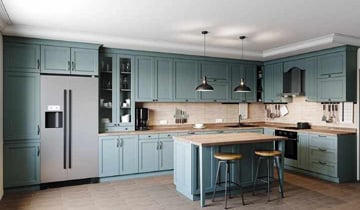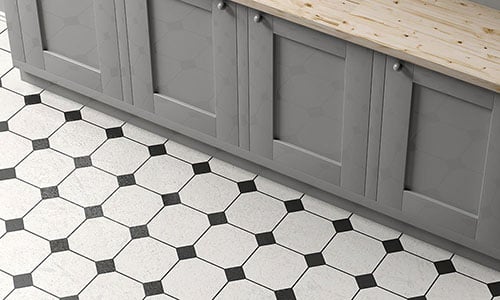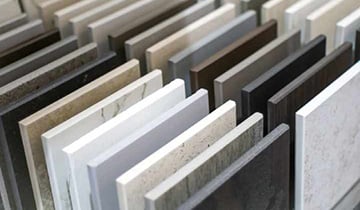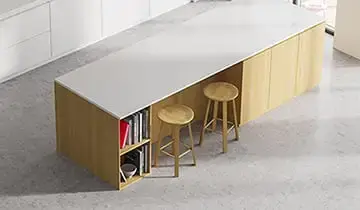9 min read
What types of rooms are best suited for electric underfloor heating?
If you are researching the feasibility of electric underfloor heating for your home, you may see a lot of examples that simply talk about underfloor...

Kitchens are usually the most used living spaces in any home and are often not just for cooking but for entertaining in too. For the ‘heart of the home’ how it feels is important and over the years trends in kitchen design come and go. However, one trend that has withstood the test of time is minimalism and that just happens to suit underfloor heating down to a ‘T’.
Before we get stuck into the nitty gritty of underfloor heating and kitchens, here’s an interesting fact about how long us Brits spend in the kitchen.
Ready?
Brits spend anywhere between 61 and 72 minutes per day in the kitchen. That’s a huge 22,265 to 26,280 minutes each year.
For a room where we generally spend a lot of time (excluding entertaining), it definitely needs to ooze total comfort.
As we are focussing on the kitchen, we’ll relate some of the benefits to it. However, if you want to know the ‘ins and outs’ when it comes to the benefits of underfloor heating you’ll find in-depth articles on our Heating Blog which you can digest at your leisure.
If you decide to install wet or electric underfloor heating, you’ll be able to take advantage of these benefits.
Comfortable heat: Underfloor heating helps to keep humidity in the air as well as evenly spreading the heat from the ground up. There is no stuffy heat made even worse when you open the oven to retrieve your perfectly cooked roast potatoes.
Greater efficiency: Electric underfloor heating, as an example, operates at much lower temperatures and is 100% efficient at point of use. Each joule of energy paid for is used at the exact point where the heat it is needed.
Environmentally considerate: Yep. You guessed it. Underfloor heating is better for the environment compared with traditional systems. In particular, electric heating is favoured in the soon to be released SAP 10 calculations. Why? Because electric produces much less carbon emissions compared with gas alternatives.
And there are two benefits of underfloor heating in kitchens which we think you’ll really love…
Design freedom: For a clean minimalist design, you ideally want your walls to be free of radiators. With no radiators on the wall, you will experience the ultimate design freedom and the joy of being able to place furniture and kitchen units exactly where you want. Electric underfloor heating would mean no radiators, and that wall space can be used for more kitchen units.
Better control: Not only will you conserve energy by being able to control your heating room by room, but you’ll also save on your energy bills. Because electric underfloor heating is so reactive to temperature demands and changes (it can heat up within 15-20mins), it makes a great addition to a kitchen. In a kitchen, you are likely to have loads of other heat sources – ovens and hobs obviously, but also fridges and freezers kick out heat. So, it is possible that with a hydronic (wet) central heating system, the kitchen will get too warm for comfort. Electric underfloor heating can react very quickly to these changes in temperature, and therefore maintain comfort, whilst saving money and energy.
When it comes to kitchens, the most popular floor finish is ceramic tiles. Not only are they durable, but they are also easy to maintain and available in a variety of colours and designs which give you more flexibility in the final look and feel of your kitchen.
Tiled floors are a perfect fit for underfloor heating because they are a superb conductor of heat. Tile thickness has little impact on heat output, but sometimes thicker finishes (up to 20mm) can increase the heat up time whilst the heat transfers through, but it will also hold the heat for longer. Most internal floor tiles are approximately 10mm – 12mm thick which is ideal for underfloor heating. Porcelain and Ceramic tiles are also more affordable compared to stone floor tiles which is another reason why they are so popular in kitchens.
If you plan to use another floor finish, such as wood, it’s worth reading our blog post which is cleverly titled ‘The best underfloor heating for wooden floors’. It has everything you need to know before installing underfloor heating under a wooden floor.

Firstly, let’s start with identifying the risks
Cracking of the tile or the grouted joints is one of the biggest risks when using underfloor heating under tiles. Reasons can include temperature variations in the tile and/or substrate due to heating and cooling cycles. Seasonal temperature changes can also cause cracks to appear.
Another risk is snagging the heating cable (if installing electric underfloor heating) with the trowel when applying adhesive ready for the tile to be laid on.
Finally, ensure the subfloor that you are installing your underfloor heating on is level. This is key to ensuring that the heat is distributed consistently and not effected by differing thicknesses of adhesive cover.
These risks can be reduced by making sure your installer uses a flexible cement-based tile adhesive and grout to make adequate provision for expansion and contraction (movement joints).
As ThermoSphere are a British manufacturer of electric heating, we’ll focus on what is the best electric underfloor heating system to use in kitchens. If you need advice for wet underfloor heating, head on over to WMS Underfloor Heating who will be able to give you all the advice you need.
Heating and decoupling systems
A heating and decoupling membrane system is a more recent innovation for heating floors. There are lots of different brands of these systems out there which include Schluter, Warmup, and of course us! Decoupling membrane is designed to prevent cracking, lifting and delamination of tiled floors. The membrane acts like a decoupling layer allowing the tiled surface to move independently from the subfloor. It mitigates any potential damage to a tiled floor caused by expansion and contraction, whilst at the same time, holding the heating cable in place via dimples (or studs). How the heating cable is held in place by the can vary between brands.
Heating and decoupling systems also allow for different heating outputs. This is done by changing the spacing between the cable. For example, using ThermoSphere Membrane, you can use a two-stud spacing for an output of 195W/m2 (ideal for wet rooms) or a three-stud spacing for an output of 130W/m2 (great for well-insulated buildings).
An additional benefit of a heating and decoupling system is that it protects the heating cable. How? The heating cable is pressed in-between the studs causing any potential damage caused by a heavy hand using a trowel to be mitigated.
Mesh mat (heating mat) systems
The traditional mesh mat system is also suitable for your tiled kitchen floor. These types of heating mat include, Heat Mat’s Heating Mats, Flexel’s ECOFLOOR Mats, Warmup’s StickyMat System and our ThermoSphere Mesh mat.
Many of these mats are installed wire side up and the heating cable comes pre-spaced on top of the mesh. But, there’s a potential challenge for the installer. When spreading the flexile tile adhesive (or levelling compound) over the mat there is a greater risk of damaging the heating cable with the trowel (if you aren’t careful). This damage could cause the underfloor heating system to fail either when it is first switched on or during the years following. To help reduce this risk it’s better to buy a mesh system which is installed wire side down so the mesh protects the heating cable from accidental damage.
When it comes to tiled floors and underfloor heating, there’s the substrate below the heating cable and flexible tile adhesive with the tiles above. If you don’t include insulation board, the heating cable will warm the layer below and the layer above at exactly the same rate. Therefore, taking twice as long for the floor to heat up to the right temperature, because half the heat is lost downwards and that will cost you more money to run.
Insulation board significantly reduces heat loss and less time is needed to reach optimum temperature, which in turn saves you more cash. By installing insulation board, you can improve the efficiency of an electric underfloor heating system by up to 50%!
For further information on insulation board and what type is best to use, read our dedicated insulation blog.
What is the best underfloor heating system for your kitchen? If you have decided electric is your thing, then you can’t go wrong with a heating and decoupling system. However, if you do have any more questions, our team are on hand to help answer them. Just head on over to the contact us page to start the conversation.

9 min read
If you are researching the feasibility of electric underfloor heating for your home, you may see a lot of examples that simply talk about underfloor...

6 min read
When it comes to underfloor heating, it is much more common to heat tile or stone floors than wood, carpet or vinyl. So, you can imagine why one of...

11 min read
As a British manufacturer of electric underfloor heating, we often get asked ‘What’s the best electric underfloor heating system to use?’. Sounds...